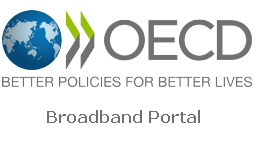Broadband
9 points
1. The determining impact of New Network technologies
2. Definition and Requirements for Broadband Access
3. The New Role of End Users
4. The Role of the State
5. The Role of Research and Academic Networks
6. The Role of Private Initiative
7. The Greek Reality
8. Conclusions of the Consultation
9. Proposed Forms of Governmental Interventions
The determining impact of New Network technologies
The speeding development of new network technologies and the forthcoming convergence of telecommunications,
information technology and electronic mass media have brought about very important inversions in the economic models
of growth in the field of Telecommunications, IT, Service and Commerce. These inversions are very determining in the
social models of organizations that aim to reassure the participation, the cohesion and the equality of citizens,
the equal communication and the access to knowledge. A State's competition in today's high technology environment
as well as in the field of digital cohesion is mainly related to the existence of advanced network infrastructure
of high quality, capacity and performance, of reasonable development and cost, that offer easy, secure and continuous access
to the international "electronic grid" of knowledge and commerce, in affordable prices and no technical exclusions.
Definition and Requirements for Broadband Access
Broadband access in a narrow sense, is identified with the ability of transmitting a large amount
of information between communicating systems and end users emphasising the ability to continuously
connect providers of multimedia content and transmitting good quality interactive video at the access
loop (last mile). Broadband access presupposes political and financial circumstances that insure the
expansion, gradual progression and sustainability of infrastructure and services requiring the
existence of network infrastructure of ultra-high speed and of similar volume, interest and economic
value of the transmitted information.
The New Role of End Users
In open network societies and economies where the growing number of participants has brought
about bigger increase at the value of the total "product", opportunities for business activity
and improvement of quality of life are multiplying. It is more than necessary to face all participating
users not as passive consumers but as possible service and added value providers.
The Role of the State
The fast development of the appropriate accessible and reachable broadband infrastructure -with no exceptions- as
well as the development of the relevant applications and services should be the State's first priority.
In order to effectively reduce the danger to expand the digital divide among citizens-users of two speeds,
broadband connection should be developed on a national and international level while giving the opportunity
and the ability for the local community to evolve.
The development and use of Broadband services by the
Public Administration, especially in the Education and Health sectors, could sensitise and spread through
those services country wide, in order to promote their use to citizens and enterprises. The State, leaving
the role of the passive "customer-consumer", could now act not only as the catalyst to forthcoming changes,
but as the active user and provider of public digital broadband services for public utilities, formation of
new dynamics and balance, speeding up the development of broadband infrastructure and services aiming to reach
the targets of the European initiative eEurope 2005.
The Role of Research and Academic Networks
Traditionally, Research-Academic Networks had a particularly strong catalytic role in the development
of advanced telematic networks (e.g. Internet Development and pilot application in the States).
In the last decade, new age research networks in the States (Abilene), Canada (Canarie), Japan (APAN)
and Europe (TEN-34, TEN-155, GEANT) have been the precursor of broadband networks' infrastructure.
Those networks are considered to be of high priority since they're serving researchers, professors
and students to support the promotion of research and education, creating development and testing
platforms of new ultra-high speed network technologies , and proposing new business models in the
broadband services market. In Greece, the Greek Research & Technology Network has been working
towards this direction since 1995, in cooperation with Network centers of all Universities,
Technological Institutes and research centers while the Greek Universities Network - GUnet
provides broadband access in 68 research and academic institutions and is also connected to
pan-European GEANT network with 1.2Gbps speed. The European Parliament and the European
Commission have decided upon the development of the next generation research networks within
the framework of the Global Terabit Research Networking - GTRN initiative.
The Role of Private Initiative
Liberalisation of telecommunications has led to develop a regulatory framework that encourages
competitive broadband infrastructure and services, expecting to prohibit the monopolies, either
governmental or private. The decision of the E.U. Council was highly important since all 15
member-states were obligated to legally disengage the local loop from exclusive supply, so as
to give the opportunity to use the broadband system. This regulation combined with the development
of new wireless local loop technologies and satellite links gives the opportunity for private
investments. Nevertheless, international experience (and mostly Greek reality) shows that the
above opportunities haven't been satisfactorily exploited, probably due to recession over the
last two years, difficulties faced by telecommunications organizations on a global level
(especially after considering the high cost of purchasing a 3rd generation mobile license)
and techno-economic obstacles of traditional telecommunications monopolies
(connection costs and co-installation).
Greek Reality
Especially in Greece, all evidence show that the combination of inherent characteristics of the local market
and the lack of competition in telecommunications (mobile telephony excluded) will not allow fast growth of
broadband access, compared to E.U. partners and OECD. This fact imposes the suggestion of ambitious but realistic
goals. The lag of taking actions, especially in this crucial period of undertaking coherent actions of
technological upgrading which are impossible to be fully implemented without broadband communicative
infrastructure, will lead the country in a much more difficult situation within the global competitive economy.
As far as the availability of broadband services is concerned that was promised by OTE or by its competitors, there won't be the expansion needed of the existing infrastructure and services under the dominant system of business models and practices, where broadband infrastructure development and access in communication networks, will be dealt as a by-product of telephony services' market.
Conclusions of the Consultation
At the consultation with the licensed companies, regarding the most important obstacles in developing a competitive market for broadband access services, worries regarding the following issues were stressed out:
 The creation of an appropriate institutional, regulatory and business framework including governmental initiative, public and private accomplice and cooperation spirit among providers.
The creation of an appropriate institutional, regulatory and business framework including governmental initiative, public and private accomplice and cooperation spirit among providers.
 Broadband services cost
Broadband services cost
 Whether there will be acceptance and participation of the public in those services, especially with the non supply of content from governmental bodies.
Whether there will be acceptance and participation of the public in those services, especially with the non supply of content from governmental bodies.
 The important role of OTE in connection services supply and the importance of supplying such services in competitive prices in relation to other companies' prices that will develop their own services on a local level.
The important role of OTE in connection services supply and the importance of supplying such services in competitive prices in relation to other companies' prices that will develop their own services on a local level.
 Actions for common infrastructure development (community broadband networks and condominium fiber) are treated in a positive way by most providers.
Actions for common infrastructure development (community broadband networks and condominium fiber) are treated in a positive way by most providers.
 One out of two bodies believes that there should be financial assistance (in a form of grant and/or tax relief) by the State, while it is required to create a healthy business model with clear rules of activations and investments.
One out of two bodies believes that there should be financial assistance (in a form of grant and/or tax relief) by the State, while it is required to create a healthy business model with clear rules of activations and investments.
 It is very important to support the views to fuel the demand for broadband services, initially by the public sector (mainly education and health) whereas further development could be achieved by training citizens in new technologies.
It is very important to support the views to fuel the demand for broadband services, initially by the public sector (mainly education and health) whereas further development could be achieved by training citizens in new technologies.
Proposed Forms of Governmental Interventions
Broadband in full extent demands the existence of core networks of fibre optics on a national and regional level. In order to expand to the end user it is necessary to develop dense broadband infrastructure on the last mile. In the short run, it is important to distribute cost-effective solutions such as xDSL, LMDS and satellite services taking advantage of the Greek satellite HELLAS-SAT, especially in distant areas, in order to encourage demands and create the prerequisites for a competitive market.
Greek telecommunications market still depends on the fibre optics core network of the main provider (OTE). The new entrants have just taken some careful steps in developing broadband infrastructure by fibre optics and LMDS. The dependence on OTE increases the risk of the new entrants since they are required to sign interconnection agreements, use of Unbundled Local Loop for xDSL and co-installation.
In order to reach the desired market level, the State should be activated in broadband telecommunications in the following ways:
 As a Policy reformer, placing institutional and regulatory frameworks and targets for the implementation of new to Greece- mixed business models where private and public representatives co-exist following international practices.
As a Policy reformer, placing institutional and regulatory frameworks and targets for the implementation of new to Greece- mixed business models where private and public representatives co-exist following international practices.
 As a big user of network services.
As a big user of network services.
 As the initiator and administrator of direct or indirect
As the initiator and administrator of direct or indirect
The demand by public services, health, education etc and the upgrade of those services to cover the needs in wide range is creating real broadband demands and consequently encourages the development of required network infrastructure, that will be used in order to provide services at low-cost at any geographical location. Their development will come out through cooperation between municipals, prefectures, telecommunication organizations and committees from education, research, health and public administration having as a consequence the informing and awakening of citizens, on what is technologically available and how it could improve their quality of life.
In conclusion, there are certain recommendations- actions proposed, with a specific timeline. Most important of those were dealt until the end of 2005, with the development of fibre optics networks on a regional level, the creation of National Network of Public Administration and the spotlight of a number of issues that set as their goal to create the environment for a healthy and competitive market.














